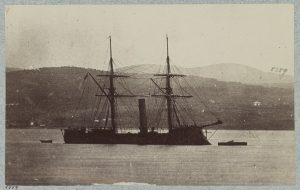Symposium Spotlight: Ambitions and Challenges of a Confederate Navy European Ironclad Squadron

Welcome back to our yearly spotlight series, highlighting speakers and topics for our upcoming symposium. Over the coming weeks, we will continue to feature previews of our speaker’s presentations for the 2022 Emerging Civil War Symposium. We’ll also be sharing suggested titles that you may want to read in preparation for these programs. This week we feature Neil P. Chatelain.
Break the blockade!
It was the Confederate Navy’s continuous mandate. President Abraham Lincoln’s blockade of the Confederate coastline was a constant reminder of U.S. naval superiority. Its continuous presence deprived the Confederacy of much-needed supplies and stymied international recognition. Breaching this barrier would affect the war from political, economic, and diplomatic standpoints.
Locally built Confederate ironclads were originally envisioned to break the blockade directly. They failed on three separate occasions: at the Mississippi River’s delta in October 1861, at Hampton Roads in March 1862, and at Charleston in January 1863. Stronger warships were needed.
As battles dotted the American landscape, a shadow war waged across Europe by a few dozen diplomats, agents, and naval officers over whether the Confederacy would forge a naval force capable of contesting the United States. Elements of this conflict are well known, such as the acquisition and deployment of the Confederate commerce raiders Florida, Alabama, and Shenandoah. The other major element of this European naval campaign is far more obscure, but might have tipped the war to the Confederacy’s favor by providing an ironclad squadron capable of breaking the blockade.

Confederate Navy Secretary Stephen Mallory sought to build an ironclad squadron abroad. Some of the Confederacy’s most senior and capable naval officers, including Captain Samuel Barron, Commander James Bulloch, and Commander Matthew Fontaine Maury, were dispatched to realize this fleet of modern ironclads and wooden warships. Scouring England, Scotland, France, and Austria, contracts were signed for five ironclads and four wooden corvettes to be delivered in late 1863 and early 1864. If properly manned and armed, this flotilla might breach the Atlantic seaboard’s blockade, potentially opening the Confederacy to critical supplies, disrupting U.S. military campaigns, threatening Abraham Lincoln’s reelection, and realizing international recognition of Jefferson Davis’ government.

A Confederate squadron of five ironclads, supplemented by wooden steamers, could match the ironclads and wooden warships blockading individual Confederate ports in numbers and strength, that is if it could be safely built, delivered to the Confederacy’s agents, properly manned, and adequately armed and supplied. To secure this squadron, the Confederacy waged misinformation campaigns across northern Europe and the Mediterranean Sea. By keeping contracts secret, using European intermediaries, hinting at foreign ownership, and seeking acquiescence from sympathetic European governments, Confederate agents hoped to sneak their ships out to sea past the noses of United States diplomats.
They failed.
Counters by U.S. diplomats and enforcement of European neutrality laws challenged these clandestine efforts, and though all five ironclads and four corvettes were eventually built, only one ever flew the Confederate ensign, and far too late to materially affect the war. The blockade remained in place and Abraham Lincoln’s reelection was secured, paving the way to a final U.S. victory.
Find more information on our 2022 Symposium by clicking here.
It is reported that “a single Argentine submarine could have disrupted British operations during the 1982 Falklands War.” And a single Confederate States of America submarine attempted operations during the War Between the States… just one of many “innovative attempts at disruption,” along with Laird Rams. If delivered in early 1863 as contracted, these powerful ironclad vessels, impervious to attacks by anything then afloat, had potential to re-open Southern ports and threaten Northern ports. And the war may have continued just that little bit bloodier, and longer. The British decision NOT to allow the delivery of these weapons of war… was inspired.
Great points to bring up. At the symposium I will be examining the critical British decision, as well as those of other European powers, to intervene in these Confederate naval acquisitions. I will also look at the capabilities of the Laird rams, as well as other vessels. A close comparison of their armament and armor with that of U.S. blockading forces might bring forth some interesting surprises.
Perhaps counter-intuitive, the attached link to “Early British Ironclads” describes the identification of the “optimum thickness of iron plate,” the challenge of breech-loader versus muzzle-loading artillery, and the adoption of the turret aboard warships. And, beginning at the 46 minute 20 second mark and running four minutes: a concise description and brief history of the Laird Rams. Published by Drachinifel on 11 AUG 2021: https://www.youtube.com/watch?v=R073-bq6rUE